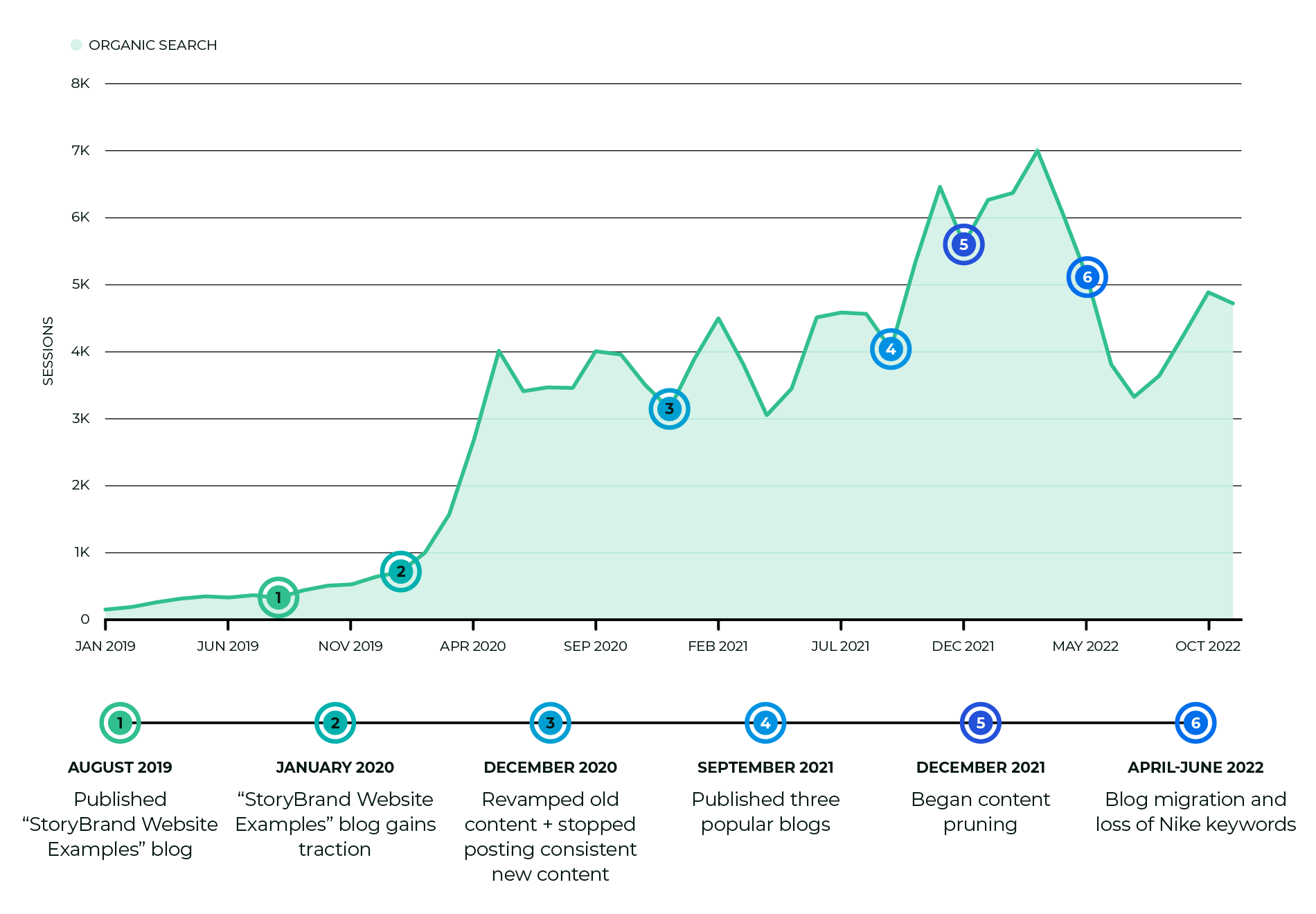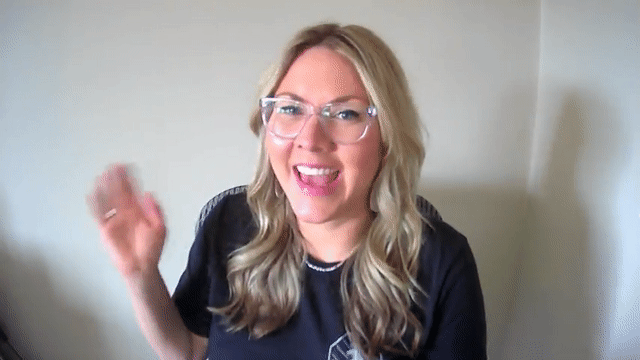We haven’t always ranked on the first page of search results. In fact, there was a time when we hardly ranked for any keywords at all. We started with nothing and in recent years we’ve started to see significant gains in organic traffic.
At the end of 2019, we decided it was time to up our content game. We wanted to drive more organic traffic to our website and appear higher in Google search rankings. To accomplish this, we developed a detailed content strategy centered around SEO.
By February 2020, we had increased our organic traffic by 324%. Since then, we’ve had our ups and downs, but overall maintained a strong presence in search results and a high volume of organic sessions on our site. This study outlines how we crafted and maintained our content strategy to target SEO opportunities and scale our organic reach.
The Problem
Our organic traffic analytics for 2018, which had 117 sessions at its peak.
In 2018, we were hardly driving any website sessions via organic traffic. Most months clocked in at less than 100 sessions from organic, and our highest ranking month saw only 117 sessions. We knew we needed to increase our organic visibility if we were going to grow our business. Our core problem was appearing higher in search results for the audience we wanted to attract to our brand.
In 2019, when our content journey began in earnest, we established two goals for our strategy:
- We wanted higher volume and more relevant organic traffic on our site.
- We wanted to educate prospective customers throughout the sales process.
The first problem to overcome was our lack of organic traffic sessions — we weren’t pulling in many users, and those who did come were not always highly qualified to do business with us. We knew that we could drive more traffic with SEO tactics, but that wouldn’t solve the problem of unqualified leads.
So instead of focusing solely on the highest traffic opportunity, we narrowed our focus to blog topics that related to the things we did really well. That way, as we drove traffic to our site, we could also expand our business and align content with our services and goals.
Next, we addressed our goal of educating prospects throughout their pre-purchase journey with our brand. Most of our clients looked at our blog at some point in the sales cycle, even if they didn’t come to our website through organic traffic. We chose content that addressed key objections prospects had throughout the sales cycle or questions they needed to answer before making a decision.
After outlining these problems and goals, we moved on to developing and implementing our SEO strategy.
The Process
Our content strategy started in 2019 with consistent writing from Tyler. Initial content buckets were created and a few key articles were crafted around big SEO opportunities (like StoryBrand website examples).
In 2019, we were focused primarily on StoryBrand, so many of our blog articles revolved around the framework. In August of that year, we created How to Get the Most Out of the StoryBrand Framework, which was our top blog for over a year. It was also the reason our traffic finally started taking off.
When it was first published, it took a little while to gain traction, but once Google latched on, it took off. In our experience, it takes about three months for most SEO efforts to gain traction and this has held true throughout the history of our content strategy. The blog was published at the end of August 2019 and slowly gained traction until it took off in January of 2020. In just five months, the page went from 142 views to 726.
First year’s performance for “How to Get the Most Out of the StoryBrand Framework.”
Once we saw this spike, we began exploring other topic opportunities within the StoryBrand space. We conducted competitor and keyword research and found significant SEO opportunities. Not many agencies were writing valuable content and there were many low difficulty, high search volume keywords we could target.
We wrote four more blogs specifically about StoryBrand:
- What You Need in a StoryBrand Website Design
- StoryBrand Examples We Love (and Why)
- How the StoryBrand Brandscript Helps Any Product Sell Itself
- What Is StoryBrand?
Each of these blogs were able to gain some traction and generate traffic to our site. StoryBrand Website Examples We Love (and Why) is one of our top performing blogs, even today. We originally published it in 2020, but as it grew in popularity, we decided to make some changes. We refined the content and also updated the URL to what it is today.
At the beginning of 2020, when we started to see this uptick in traffic, we created topic clusters for our blogs to ensure we were writing about diverse business topics. We also used them to aid with creating pillar pages and building an internal linking system.
Our topic clusters were:
- Building an Agency
- Inbound Marketing
- Content Marketing
- StoryBrand + BMS + Messaging
- Website Design + Development
As we developed our content calendar, we looked for topics that fit within each of these clusters. This helped us capitalize on our organic growth with information that would target each segment of our audience. We performed keyword research for each blog post and wrote with a target keyword in mind, using Clearscope to ensure we included enough related keywords to be competitive in SERPs.
At the end of 2020, we created a process to evaluate all of our content to identify which articles needed updates. (Special shoutout here to Jessica Greene who has developed some incredibly detailed and insightful processes for revamping content.) Our primary goal was to address articles that were losing traffic because they were falling behind in search rankings. We used a Databox reporting dashboard similar to Jessica’s so we could see the traffic each of our posts was getting. If we saw a sharp decline for one post, especially if it was previously driving lots of traffic, then we checked the search rankings for that page. If it was falling in rankings, then we updated it to help buoy it back to the top of search results.
In late 2020, we began updating those articles by optimizing them for a target keyword that met three criteria:
- Relevant to our topic
- Attainable difficulty and reasonable search volume
- Search intent match
These three criteria represented three aspects of Google’s ranking algorithm: domain authority, relevance, and search intent. By focusing on these three things, we were able to choose the keywords that would likely have the highest return for our efforts.
One important element to note is our domain authority. When we began developing a content strategy, we didn’t have a lot of SEO juice behind our brand. As we created new content, we paid special attention to internal and external linking strategies to help boost our domain authority. We also built backlinks by reaching out to websites that mentioned our brand and asking them to include a link to our site.
As we updated each blog, we edited for clarity, grammar, new information and Clearscope keyword and heading suggestions. The goal was to get each piece at an A+ or higher grade. We also updated the photo sizes for each image in our previous content because many of them were too large and slowed down page load speeds (which hurts your website’s SEO score).
We started posting new content more consistently again around April 2021. We began posting a new article (almost) every week, written around a target keyword that fit our parameters. The combination of updating blogs and publishing new content brought another bump in our organic traffic.
We published three popular blogs in September, which resulted in the spike during October and November. Those blogs appearing high in SERPs helped our website overall become more discoverable and created this increase in organic traffic.
At the end of 2021, with our content strategy in full swing, we started pruning our content. We looked for pieces that weren’t ranking for any keywords, didn’t offer any valuable information or that were duplicates of other blogs we’d created. We added redirects from these pages to other blogs on our site before removing them from our site.
Redirecting those blogs was a critical step. Without redirects in place, you risk users encountering a 404 error on your website, which can significantly drag down your SEO.
In 2022, we continued with our content strategy, consistently publishing one blog per week. We reached our peak organic traffic in March, with just over 7,000 sessions that month.
You can see in the graph below that traffic took a dip after that. We’d migrated articles from another site into ours which resulted in some competing keywords that, coupled with reduced posting, drove our traffic down.
Again, you can see the three month rule at work. For the three months post-migration — April, May and June — our traffic was trending significantly down. However, in July, we started to see an uptick from the content we’d been publishing over the summer.
In August 2022, we performed a full content audit and once again began updating and pruning our blogs, including the content migrated from the other site. Since beginning that process, we’ve seen a steady increase in organic traffic that should continue to grow.
? Ready to grow your traffic? Let’s chat about it.
The Results
We started with nothing and, within two short years of implementing our content strategy, reached a height of over 7,000 organic sessions in one month. All through a research-driven approach to creating content.
Overall, our SEO content strategy has resulted in three major achievements:
- Over four years, growth from 130 organic sessions per month to over 7,000
- Organic traffic now consistently makes up 65-75% of our website sessions
- Published four pivotal blogs that still drive the bulk of our organic traffic
Pivotal Blogs
The following are our overall top 4 performing blogs.
Nike’s Brand Positioning
Our blog about Nike’s Brand Positioning has become a powerhouse post. As you can see above, it generated over 25,000 views in the last year, nearly 24,000 of which were entrances to our website.
Since it was published, it’s created one new contact for our business. It’s worth noting that the post may have produced more contacts, but they were deleted due to lack of engagement to keep our database clean. You’ll notice its traffic follows the general pattern of our overall traffic, dipping down around April and pulling back up in August when we began revamping old content.
Initially, this blog was responsible for roughly 1,000 keywords that our domain owned. However, over time, this number has dropped significantly as Google continues indexing and analyzing search intent around this topic. Many of the keywords we lost simply didn’t fit the search intent behind our content, so we anticipated those dropping off.
Currently, the blog ranks for 521 total keywords, 20 of which appear on the first page of SERPs and 9 are positions 1-4. It ranks in position one for four different keywords and others are making steady gains.
We also placed a downloadable brand positioning worksheet within the via a form on the page. This created a space to generate bottom of the funnel conversions on the page. We’ve had 83 form submissions to date from this blog.
Why Email Marketing is Still Important
The second most popular blog is Why Email Marketing is Still Important. This was originally published in 2020, but we’ve updated it each year to keep it relevant to trends in marketing.
Although our CMS doesn’t attribute any revenue to the page, you can see it earned us 9 form submissions and 7 new contacts. Plus, it’s responsible for bringing a significant amount of traffic to our website.
In the graph, you can see the upticks about three months after we updated the content for each year. Traffic has started declining for the end of 2022, but we expect another increase when we update for 2023.
This piece is able to drive so much traffic because of how well it does in search results. It ranks for a total of 308 keywords. It’s in one of the top 4 positions for 13 different keywords and on the first page of SERPs for 15 keywords.
StoryBrand Websites We Love (and Why)
The first pivotal blog is one we’ve already mentioned, StoryBrand Website Examples We Love (and Why). Since we updated and re-published this post in January 2021, it has received nearly 37,000 page views, created 11 new contacts and generated almost $6,000 in revenue for our business.
If you look closely at the page views, you can also see that 93% of people who viewed this page entered our website through it. That means they found it through organic search and it was the first page they viewed on our site during that session.
The image above shows our top keywords for this blog by position. You can see we’re still making gains after our most recent update. Although many of our results are on the second page of SERPs, we do have three keywords for which we rank on page one and that are still gaining traction.
What Does Above the Fold Mean? And Why Is It Important?
Originally published in 2017, this blog went from an underperformer to our fourth most popular blog. It was updated twice — initially in 2020 and again to its current state in 2021. The second update is what really started to show results.
The page has created two new contacts for us and brought in a little over 10,000 page views during its lifetime. What’s remarkable, however, is that 7,841 of these views occurred within the last year.
You can see our rule of three at play again in this graph. We updated the blog in May of 2021 and by August its traffic had doubled from 150 views to 300. By November 2021, it had 499 views, and it reached its peak in May 2022 with 721 views.
This growth is well-explained when we look at the keyword rankings for the blog.
This blog owns 102 keywords, 26 of which put us on page one of SERPs. That’s one fourth of the total keywords ranking on page one. Of those 26, six keywords are in position one. You’ll notice that the search volume isn’t as high on these keywords as in our other examples, but the difficulty levels are significantly tougher. This means we’re performing well and closely matching search intent in a highly competitive space.
Content Value
Boosting our SEO through content marketing has helped to increase our domain ranking, which makes us more discoverable overall. This means more people can find our web pages and landing pages, in addition to blogs, when performing a search.
We can attribute more than $100,000 of the previous year’s revenue to organic search and that is with the most conservative attribution.
Content Marketing Works
Many people avoid content marketing because they’d prefer to invest in a quick win. Although quick wins are important, having a long-term strategy that builds a machine for your revenue is invaluable.
Our content serves to bring traffic to our website, supplement our sales process and educate prospects and customers alike. Using a data-driven SEO strategy has proven significant results for our brand, both in brand awareness and revenue.
Ready to build your SEO presence? Our team would love to chat.







